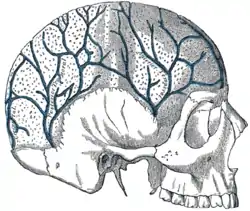| Diploë | |
|---|---|
 Veins of the diploë as displayed by the removal of the outer table of the skull. | |
| Details | |
| Vein | Diploic veins |
| Identifiers | |
| Latin | diploe |
| TA98 | A02.1.00.035 |
| TA2 | 438 |
| FMA | 76630 |
| Anatomical terminology | |
Diploë (/ˈdɪploʊi/ or DIP-lo-ee) is the spongy cancellous bone separating the inner and outer layers of the cortical bone of the skull.[1] It is a subclass of trabecular bone.[2]
In the cranial bones, the layers of compact cortical tissue are familiarly known as the tables of the skull; the outer one is thick and tough; the inner is thin, dense, and brittle, and hence is termed the vitreous table. The intervening cancellous tissue is called the diploë. In certain regions of the skull, this becomes absorbed so as to leave spaces filled with liquid between the two tables.
Etymology
From Ancient Greek διπλόη (diplóē, “literally, a fold”), noun use of feminine of διπλόος (diplóos, “double”)
References
- ↑ "Definition of DIPLOE". www.merriam-webster.com.
- ↑ "Foundational Model of Anatomy - Diploe - Classes | NCBO BioPortal". bioportal.bioontology.org. Retrieved 25 January 2023.
![]() This article incorporates text in the public domain from page 80 of the 20th edition of Gray's Anatomy (1918)
This article incorporates text in the public domain from page 80 of the 20th edition of Gray's Anatomy (1918)
External links